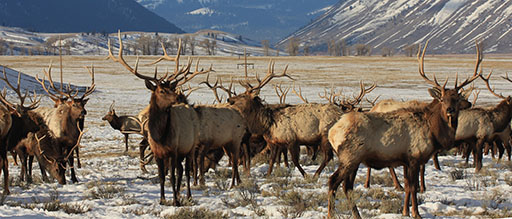By Mike Koshmrl
Jackson Hole Daily
Via- Wyoming News Exchange
JACKSON — The National Elk Refuge’s big rigs spewed out alfalfa pellets for the last time in 2021 on Monday, marking the end of a feeding season that has been abridged by about two weeks to meet management goals.
Using snow depth as the benchmark, refuge staff in an ordinary year would have fed the 8,500 or so elk on the property through around April 12. But because of an elk feeding “step-down” plan that is taking effect, the end date this year will instead be March 29.
“We’re on our way to fully implementing the step-down plan,” refuge biologist Eric Cole said. “This is consistent with what’s in the plan.”
Next winter the plan will move into the next phase: delaying the onset of feeding, likely by about one week. Feeding started one week later than average this past winter, but that delay was related to forage conditions and was not a result of the management plan that is taking effect.
The eventual goal is to reduce the volume of feed distributed by half. But the federal plan, which was shaped by the Wyoming Game and Fish Department, is facing litigation from Earthjustice. The law firm is representing environmental groups worried about how the recent arrival of chronic wasting disease will impact the unnatural congregations of ungulates that spend the winter in the same place.
“The agency’s step-down plan defines success at a level of reduced feeding that would still leave nearly half of the Jackson elk herd — 5,000 elk — densely concentrated on artificial feedlines for more than 50 days each winter,” Earthjustice’s complaint states. “According to Dr. Thomas Roffe … this level of artificial feeding ‘still leaves a substantial risk of catastrophic disease propagation’ in the Jackson elk herd.”
Even though feeding is ending two weeks early this year, Cole predicts that it is “very unlikely” that elk will take off to find alternative food sources in places like Spring Gulch.
Warmer weather is in the forecast over the weekend, the snowpack is steadily melting and the grasslands are showing the early signs of spring green-up, he said.
Recent elk counts were more than 70% higher than the refuge’s 5,000-animal goal. High counts like that can create conditions where the refuge flats are a wet, poop-filled mess, but Cole said the elk winter range is in pretty good shape.
“It’s in surprisingly good condition,” Cole said, “because with the relatively short season, we’ve had the opportunity to spread animals out onto clean ground, in most cases.”
Early mortality data suggests that elk had better-than-average survival rates this past winter. Through this week, Cole and his staff had tallied 70 carcasses — less than 1% of the winter population — although that count is expected to climb in coming weeks as elk succumb to “foot rot” and other diseases.
None of the dead elk encountered this past winter, he said, have tested positive for CWD, a lethal disease that was found in the Jackson Elk Herd for the first time last fall.
Besides the thousands of elk, about 300 bison, 66 bighorn sheep and three pronghorn have been seen on the refuge in recent weeks.
Wolves have also been visible with some regularity, including on the southern, more accessible end of the federal wildlife refuge.
Cole is also seeing many signs of spring out on the landscape: Red-winged blackbirds, red-tailed hawks, mountain bluebirds and Western meadowlarks have all made their first appearances of the season over the past several weeks.
“I’m still waiting for the first report of Uinta ground squirrels emerging from hibernation,” Cole wrote in a biological update he distributes, “but it probably won’t be long!”






